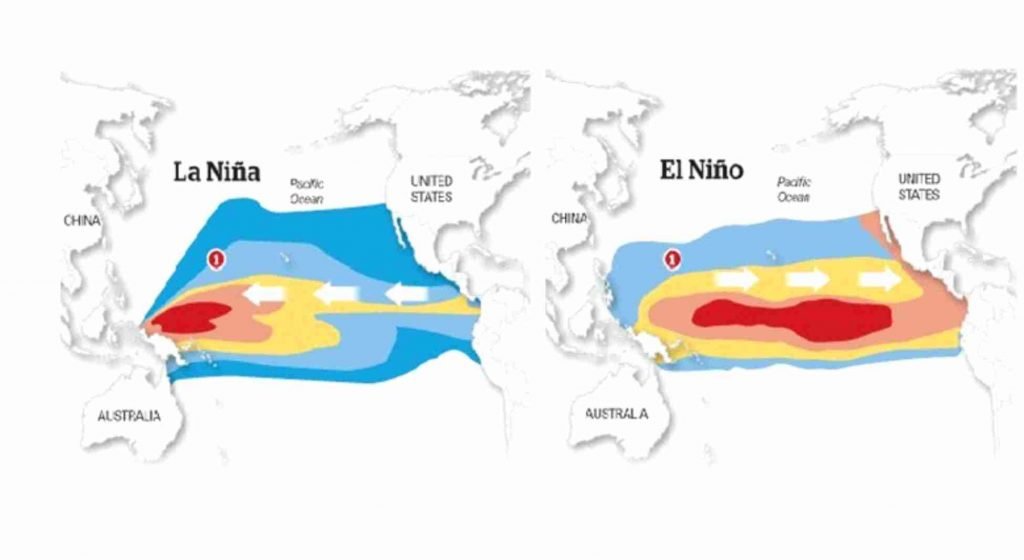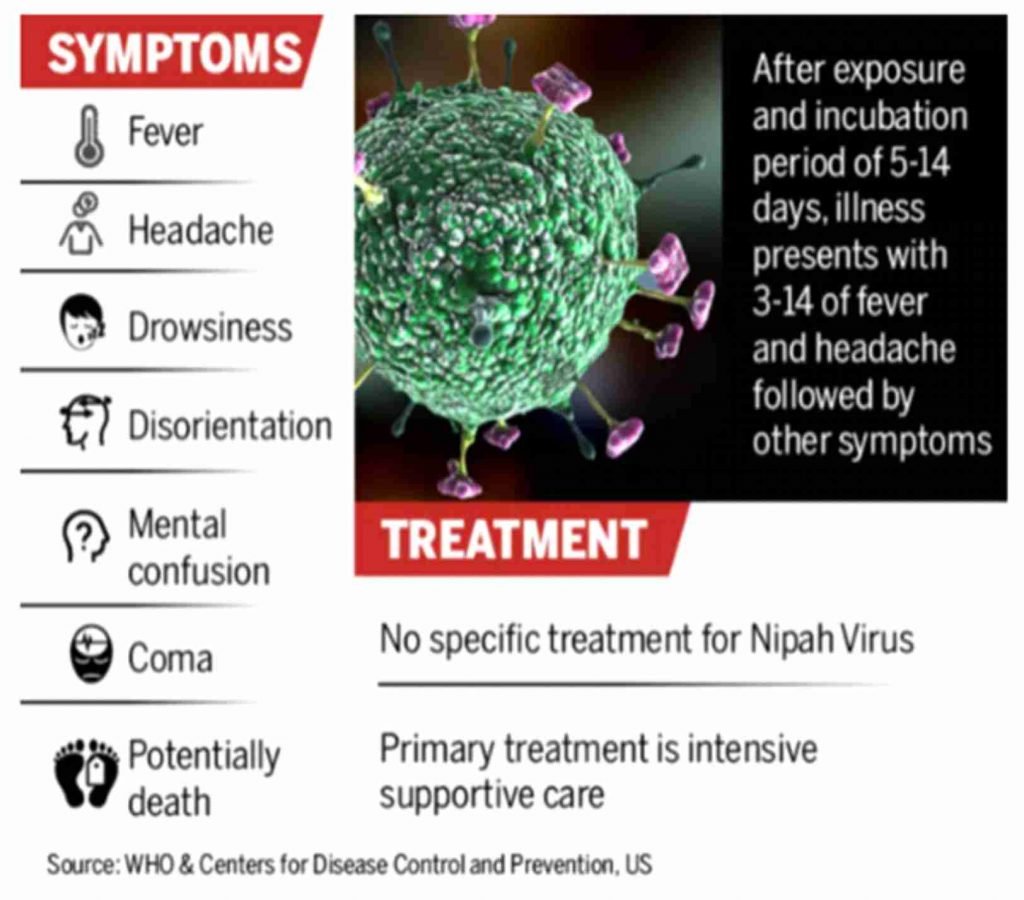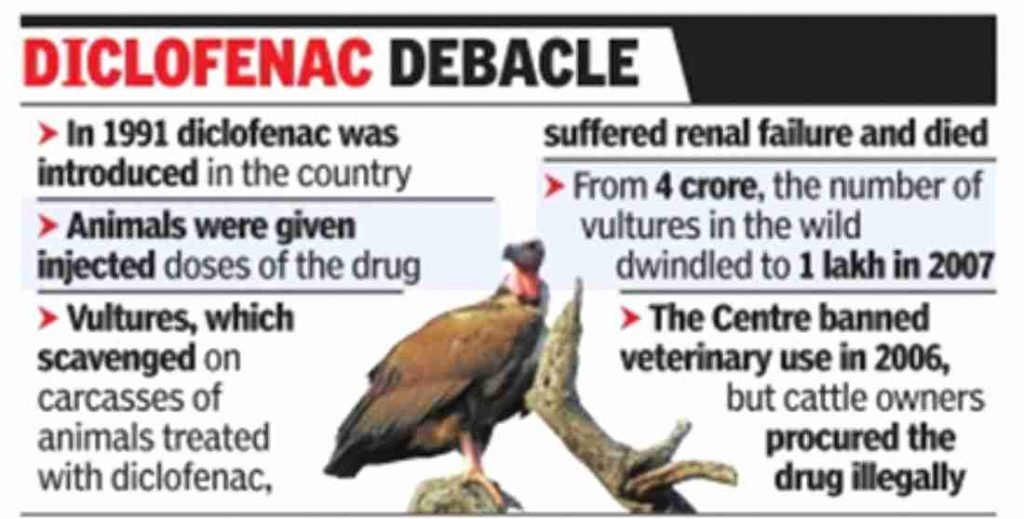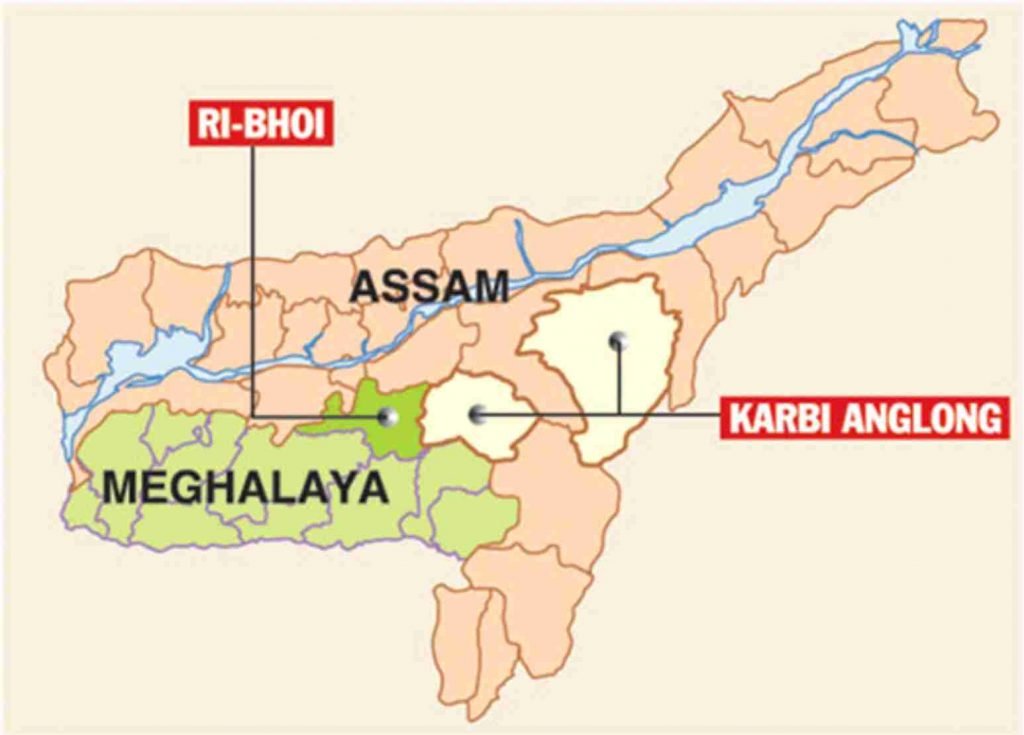El Niño, La Niña
Indian Express
GS 1: Geography
Context:
- El Niño and La Niña, the two natural climate phenomena occurring across the tropical Pacific Ocean, influence the weather conditions all over the world.
- A paper published in Nature Climate Change noted that climate change can cause extreme and more frequent El Niño and La Niña events.
About:
- El Niño period is characterised by warming or increased sea surface temperatures in the central and eastern tropical Pacific Ocean.
- La Niña event causes the water in the eastern Pacific Ocean to be colder than usual. Together, they are called ENSO or El Niño-Southern Oscillation.
Findings:
- Increasing atmospheric carbon dioxide can cause a “weakening of future simulated ENSO sea surface temperature variability.”
- The intensity of the ENSO temperature cycle can weaken as CO2
- They also noted that future El Niño events will lose heat to the atmosphere more quickly due to the evaporation of water vapour.
- In the future there will be a reduced temperature difference between the eastern and western tropical Pacific, inhibiting the development of temperature extremes during the ENSO cycle.
- There is a tug-of-war between positive and negative feedback in the ENSO system, which tips over to the negative side in a warmer climate. This means future El Niño and La Niña events cannot develop their full amplitude anymore.

New Nipah Outbreak
Indian Express, The Hindu
GS 3: Health
Context:
- A 12-year-old boy died in Kozhikode, after being infected with the Nipah virus. He presented symptoms of encephalitis and myocarditis — inflammation of the brain and heart muscles respectively.
About:
- Nipah virus (NiV) is a ‘zoonotic’ virus.
- It is transmitted to human beings from animals.
- It can also be transmitted through contaminated food, or directly between people.
- The pathogen that causes NiV encephalitis is an RNA virus of the family Paramyxoviridae, genus Henipavirus, and which is closely related to the Hendra virus (HeV), which was isolated in Australia in 1994.
- The animal host reservoir for both HeV and NiV is the fruit bat (genus Pteropus), which is commonly known as the ‘flying fox’.
- Infected fruit bats can spread the disease to other animals as well, such as pigs — and also dogs, cats, goats, horses and sheep.
- Human beings can get infected if they come in close contact with the infected animal — bats or other animals such as pigs — or its body fluids such as saliva or urine.
- The initial jump of the virus from animal to human is known as a ‘spillover’ event in an outbreak.
- Once the infection has moved to humans, person-to-person spread of NiV can occur.
- The Nipah virus is known to spread far more slowly than SARS-CoV-2. However, it is its ability to kill that is the biggest concern.

Vanniyar Movement
Indian Express
GS 1: Society
Context:
- The government in Tamil Nadu has announced the construction of a memorial in Villupuram to people killed in police firing and clashes in 1987. During a movement, people demanded reservation for the Vanniyar community.
About:
- Vanniyars are one of the largest and most consolidated backward communities in the state. They had raised massive protests in the mid-1980s demanding 20% reservation in the state, and 2% in central services.
- Their movement was backed by the Justice Party as well as the Self-Respect Movement. Organised protests began with the formation of Vanniyar Sangam, headed by S Ramadoss.
- The Vanniyars declared an agitation from September 17 to 23, 1987, which turned violent.
- In 1989, the OBC quota was split into two: Backward Castes and Most Backward Castes (MBCs).
- Vanniyars were categorised among the MBCs with 107 other communities, with 20% reservation.
- Now, this community has 10.5% reservation within the 20% MBC quota.
Extinct Animal Species
Down to Earth
GS 3: Conservation
Context:
- Recently, World Conservation Congress was held in Marseille, France.
- In that meeting, International Union for Conservation of Nature (IUCN) brought latest Red List in which it highlighted that some 902 species are officially extinct.
- The Red List also shows that 30% of the species (38,543) that it assessed (138,374) face the threat of extinction.
About:
- Some 80 species are extinct in the wild, 8,404 are critically endangered, 14,647 are endangered, 15,492 are vulnerable and 8,127 are near threatened.
- Some 71,148 species are of least concern, while 19,404 are data deficient.
- Four of the seven most commercially fished tuna species have shown signs of recovery. Countries are enforcing more sustainable fishing quotas and successfully combatting illegal fishing.
| Recent status:
1. Atlantic bluefin tuna (Thunnus thynnus): Endangered to least concern 2. Southern bluefin tuna (Thunnus maccoyii): Critically endangered to endangered 3. Albacore (Thunnus alalunga) and Yellowfin tunas (Thunnus albacares): Near threatened to least concern |
- Despite global improvement at the species level, many regional tuna stocks remained severely depleted like smaller native western Atlantic population of Atlantic bluefin tuna, which spawned in the Gulf of Mexico, had declined by more than half in the same period
- Other tuna species like the bigeye tuna (Thunnus obesus) remain vulnerable while the skipjack tuna (Katsuwonus pelamis) remains least concern.
- The update Red List also showed that 37 per cent of the world’s shark and ray species were threatened with extinction.
- All of the threatened shark and ray species were overfished, with 31% further affected by loss and degradation of habitat and 10% affected by climate change.
- The world’s largest living lizard, the Komodo dragon (Varanus komodoensis), has been moved from vulnerable to endangered.
- The species is endemic to Indonesia and occurs only in the World Heritage-listed Komodo National Park and neighbouring Flores.
- Rising global temperature and subsequent sea levels are expected to reduce the Komodo dragon’s suitable habitat by at least 30% in the next 45 years.
- In addition, Komodo dragons living outside protected areas in Flores are threatened by significant habitat loss due to ongoing human activities.
Drug Debacle
Down to Earth
GS 3: Conservation
Context:
- Vultures are fighting to survive currently. Currently, seven species in Africa and eight species in India are threatened with extinction.
About:
- Vultures are nature’s most efficient scavengers, halting all the bacteria and fungus from spreading from dead animal carcasses in the environment.
- They are known for collective behaviour in their colony.
- India has lost 99% population of the three species, White-backed Vulture, Long-billed Vulture and Slender-billed Vulture.
- The Red-headed and the Egyptian Vulture populations have also crashed by 91% and 80% respectively.
- This vulnerability is threatened more as vultures are slow breeding birds, laying only one egg a year and having a longer immaturity duration after fledging.
Use of diclofenac:
- This catastrophic decline has been attributed to the use of diclofenac, a non-steroidal anti-inflammatory drug (NSAID) in veterinary practice during the 1990s.
- Vultures are exposed to diclofenac when they feed on the carcass of an animal that has been treated with diclofenac, 72 hours before its death.
- The drug is extremely toxic to vultures and impacts their kidneys and they die of visceral gout.
- Despite, placing a ban on the veterinary use of the drug in 2006, the human doses were misused for cattle treatments in the country.
- Though the usage of diclofenac in India has reduced considerably now, it is continued to be misused in some places.
Way ahead:
- In the revised National Vulture Conservation Action Plan (2020-2025), the government plans to set up eight new captive-breeding centres (eight are functioning).
- But without a check on the toxicity of these non-steroidal anti-inflammatory drugs (NSAID) and their use (misuse of diclofenac), releasing the captive-bred populations in the wild will not be considered feasible.
- The government and other stakeholders need to ensure that the environment is free from drugs that are toxic to vultures.
- With more robust policies and enforcement of rules that are immediate, we can safeguard the remnant vulture populations in the country.
- With better practices, collective motive to change human behaviour and the usage of safe drugs for cattle treatment, we can save vultures from extinction.
- Removal of diclofenac treatment in India has not proven to be a problem for animal husbandry. But continued usage of diclofenac in other parts of the world pose a threat to species found there and the future conservation of vultures in the Indian Subcontinent.

Karbi Anglong Peace Accord
News on air, the Hindu
Prelims: Current events of national importance
Context:
- The historic Karbi Anglong Agreement has been signed recently.
About:
- This accord is significant because insurgency by Karbi group has a long history in Assam which is marked by killings, ethnic violence, abductions, and taxations since 1980s.
- Karbi is a major ethnic community in Assam and are dotted by several factions and splinters.
- About 200 Karbi terrorists will be present while signing of the agreement. These 200 Karbi terrorists are part of 1,040 terrorists who surrendered before the Assam government in February 2021.
- These outfits were originated from the core demand of establishing a separate state.
- Karbi Anglong Autonomous Council (KAAC) is an autonomous district council, which is protected under Sixth Schedule of the Indian Constitution.
- Karbi National Volunteers and Karbi People’s Force joined together to form United People’s Democratic Solidarity (UPDS) in 1990s.
- UPDS put down arms and signed a tripartite memorandum of settlement, in November 2011, with Centre and Government of Assam in return of enhanced autonomy and special packages for the KAAC.


